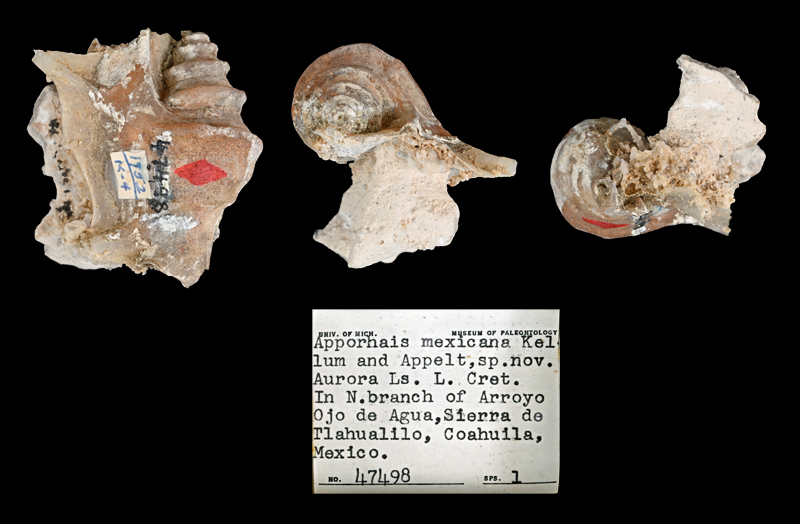Stromboidea
Original Description of Aporrhais mexicana by Kellum & Appelt, 1964:
- "Shell rather large for genus, resembling A. brittsi Stanton in general form; apical angle about 38 degrees; spire of five whorls, each prominently turreted by a high spiral ridge, just anterior to the middle of the whorl, and bearing spirally lengthened clavi or tubercles along the angulation; the whorl, concave above and below this ridge, is crossed by broad, low, axial undulations; faint axial cenulations are visible along the anterior suture above the body whorl; surface of the shell ornamented with fine revolving threads, about four in number above the angulation and eight below it on each whorl of the spire; last whorl with three prominent, rounded, carinae or spiral ridges which diverge anteriorly and pass out to projecting angles on the margin of the broadly expanded, thin, outer lip or wing; the middle carina continues posteriorly as the prominent spiral ridge, noted previously near the middle of the earlier whorls, the anterior or lowest carina, extends about half way around the body whorl to the inner lip or callous of the aperture, the posterior or highest carina, beginning at the last or anterior, radial, axial undulation that crosses the upper or posterior part of the body whorl, is only present near the aperture where the broad outer lip begins to flare to form the wing, that climbs nearly to the apex of the turreted spire; a broader, less prominent spiral undulation about equidistant between the two more prominent anterior spiral carinae of the body whorl, extends from the inner lip or callous of the aperture nearly to the area where the outer lip begins to flare. Apertzre of the holotype, obscured by heavy deposit of silicified rock, has the inner lip coated with callous that extends about half way around the shell, to an outer margin directly opposite the flaired wing; the callous, thickened greatly on anterior or lower half of whorl, is firmly cemented above and below to the shell but in the middle its margin forms a broadly ovate loop or pocket resembling a small aperture; at the broken anterior end of the shell the callous, wrapped loosely around the columella, forms a pseudo-umbilical opening."
Locus typicus: Locality on north tributary of Arroyo Ojo de Agua nearly 2 miles N 40° 15' E of the well at Ojo de Agua, Sierra de Tlahualilo, Coahuila State, Mexico
Stratum typicum: Aurora limestone, 133 ft. below the zone of Gryphaea mucronata, Albian, lower Cretaceous
Aporrhais mexicana Kellum & Appelt, 1964; north tributary of Arroyo Ojo de Agua nearly 2 miles N 40° 15' E of the well at Ojo de Agua, Sierra de Tlahualilo, Coahuila State, Mexico; Aurora limestone, 133 ft. below the zone of Gryphaea mucronata, Albian, lower Cretaceous; Holotype; coll. UMMP 47498; photographed by Jennifer Bauer; copyright University of Michigan Museum of Paleontology

